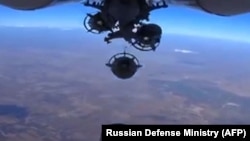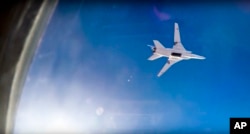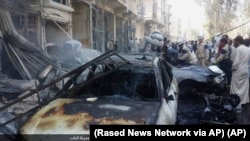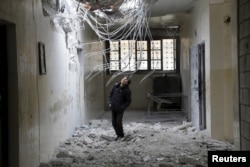By using a base in Iran to carry out airstrikes against militants in Syria, analysts say Russia is not only cutting flight time and saving fuel, but also deepening an alliance with Iran in joint support of the Syrian regime.
The move further sends a message to the United States and the West, analysts add, that Russia intends to continue expanding its influence beyond Europe and countries of the former Soviet Union.
"By strengthening their influence and their role in the Middle East, they do two things," analyst Martin Reardon of the Soufan Group — a New York organization that provides strategic security intelligence services to governments and multinational organizations — said of the Kremlin leaders.
"One, it shows the world that they are, in fact, a re-emerging global power. Second, it also offsets U.S. efforts moving back toward the Cold War era, when the U.S. and Russia were playing against each other for influence," said Reardon, a former senior FBI official.
The Russian Ministry of Defense released a video Tuesday showing two supersonic Tu-22M3 strategic bombers and one SU-34 strike fighter landing at Iran's Hamedan air base after a mission in Syria. Russian authorities said their airstrikes eliminated five major weapons depots, training compounds and command posts for the al-Nusra Syrian rebel group and Islamic State extremists.
Threat to Russia
The Kremlin says its attacks on militants in Syria are necessary because the Islamic State group, relying on thousands of fighters who come from Central Asia, poses a threat to Russian security. Tehran, which contends IS has been aiming at Iran in recent months, said its forces killed three people linked to IS in a border city Tuesday.
Until now, Russia's airstrikes inside Syria have been contained in Syrian territory. In addition to Russia's first use of a third-party air base for its military action in support of Syrian President Bashar al-Assad, this week's action also marks the first time since the 1979 Islamic revolution that the regime in Tehran has allowed a foreign power to use an Iranian air base.
"This is an important development," said Alex Vatanka, a senior fellow at the Middle East Institute and the Jamestown Foundation in Washington. "I cannot remember any other state since 1979 having been given basing permission by Iran. It brings Russia into Iran like we have not seen before.
“The official line is that it provides Russia with a backup option and less anxiety about potential anti-air missiles in the hands of the Syrian rebels that can target Russian assets based inside Syria. But as I said, it is a bigger story than just that. Russia is moving closer to the warm waters of the Persian Gulf."
Long history of involvement
Iran and Russia have been militarily involved in the Syrian conflict for years. In 2012, Iran began quietly sending its elite Revolutionary Guards to aid the regime of Syria's Assad in its struggle against rebels. Later, Iran's proxy fighters from Lebanon's Hezbollah joined in the ground battles, especially in the suburbs of Damascus. Iran has increasingly made its role in Syria public by saying it is defending a key Shi'ite shrine.
Russia, meanwhile, sent its military aircraft to Syria in September to carry out raids — first against rebels and later against Islamic State strongholds. Their presence created an uneasy détente, with the U.S. and Western allies conducting separate air raids against IS targets.
Russia also has been conducting long-range bombing missions against targets in Syria from its base at Mozdok in the north Caucasus, nearly 2,000 kilometers away. Using Iran's air base cuts that distance to less than 700 kilometers.
U.S. officials said Russia had given advance notice of its flights from Iran. A spokesman for the United States and its coalition partners fighting against the Islamic State group and other extremists in northern Syria, Colonel Chris Garver, said Russia "did notify the coalition. ... They informed us they were coming through."
Some analysts in Moscow see the deployment to Iran as an indication that Russia is intensifying its military involvement in Syria.
"Flying from Iran will cut the distance by two-thirds and enable Russia's bombers to carry up to 22 tons of ordnance," said Constantine Assiokuve of Moscow's Academy on Geopolitical Affairs.
The chief of the Russian Federation Council's defense committee, Viktor Ozerov, said the shorter flying distance would increase the accuracy of Russia's airstrikes, and the route will allow pilots to avoid advanced ground-to-air missiles in the Syrian rebels' arsenals.
‘Clear message’ to U.S.
Moscow and Tehran have been discussing the possibility of the deployment for many months, according to Iranian media reports.
In January, Moscow and Tehran signed a military cooperation deal for wider collaboration in personnel training and counter-terrorism activities. Russia's Defense Minister Sergey Shoigu and his Iranian counterpart, Brigadier General Hossein Dehghan, signed the document during a visit by Russia's top brass to the Iranian capital.
"Russians proposed this idea [a] few months ago and it was discussed with the Iranian authorities back in December 2015," said Babak Taghvaee, a Russian military expert based in Malta. "But due to unknown reasons, it was rejected until this July."
Some analysts say Russia could have safely continued bombing targets in Syria from Russia.
"Placing Tupolev Tu-22M3 bombers in Hamedan certainly shortens the distance," said Blake Fleisher, a policy analyst with the Jewish Institute for National Security Affairs. "But it's hard to believe that shortening the distance is the only reason."
Kapil Komireddi, an international affairs analyst based in Britain, said the latest developments are "a clear message to Washington that all decisions are not necessarily made in [the] White House. ... An alliance with Moscow, and letting the Russians use its bases, is a clear message from Tehran that it will do whatever it takes to serve its interests in the region."







